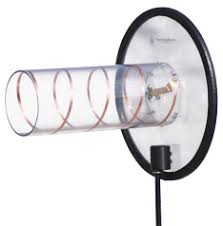Satellite Network Simulator
 Having completed most of the accounting system conversion, I had some time to return to the development of the Land-mobile Satellite Network Simulator (LMSNS). Specifically, I have manged to create a set of object classes that implement models for monofilar helical antennas operating in the first mode of the axial condition. Such antennas look much like that shown below. The objective of this activity was to work out the object/class designs for the antenna portion of the software design, but helical antennas are common among satellite systems. The software can now create an antenna object whose subclass is a helix antenna. Based upon a design frequency and number of turns in the helix an object will be created along with all of the helix parameters. I have included methods to calculate the gain pattern for the helix and a sample result is plotted below. The plot shows the hemispherical gain pattern for a 17-turn and 4-turn helix each designed for 150 MHz operation. Gain patterns at 170 MHz are also shown. Measured patterns would likely show a drop in gain at 170 MHz, but this is a consequence of the models accuracy. The models were taken from “Antennas for All Applications”, by John Kraus and Ronald Marhefka. This develops the software basis for which other antenna classes may be developed for the LMSNS. One activity will be to implement the coordinate transformations that covert a direction to a earth terminal location to azimuth and elevation angles relative to the antenna main axis.
Having completed most of the accounting system conversion, I had some time to return to the development of the Land-mobile Satellite Network Simulator (LMSNS). Specifically, I have manged to create a set of object classes that implement models for monofilar helical antennas operating in the first mode of the axial condition. Such antennas look much like that shown below. The objective of this activity was to work out the object/class designs for the antenna portion of the software design, but helical antennas are common among satellite systems. The software can now create an antenna object whose subclass is a helix antenna. Based upon a design frequency and number of turns in the helix an object will be created along with all of the helix parameters. I have included methods to calculate the gain pattern for the helix and a sample result is plotted below. The plot shows the hemispherical gain pattern for a 17-turn and 4-turn helix each designed for 150 MHz operation. Gain patterns at 170 MHz are also shown. Measured patterns would likely show a drop in gain at 170 MHz, but this is a consequence of the models accuracy. The models were taken from “Antennas for All Applications”, by John Kraus and Ronald Marhefka. This develops the software basis for which other antenna classes may be developed for the LMSNS. One activity will be to implement the coordinate transformations that covert a direction to a earth terminal location to azimuth and elevation angles relative to the antenna main axis.


